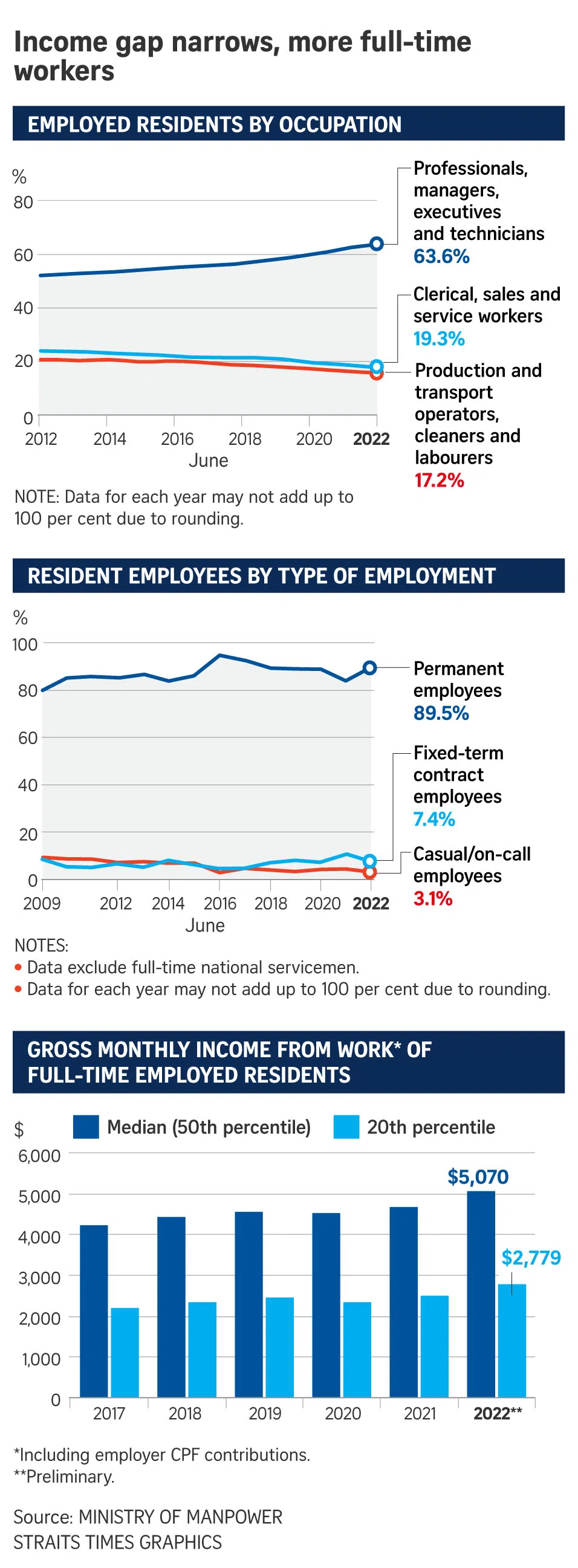Singaporeans, PRs saw 2.1% rise in real median income this year despite inflation: MOM
Sign up now: Get ST's newsletters delivered to your inbox

The employment rate for Singaporeans and PRs rose for the second straight year to 67.5 per cent in June.
ST PHOTO: KUA CHEE SIONG
Follow topic:
SINGAPORE – Higher inflation ate into the take-home pay of resident workers in 2022, but real median income still grew at 2.1 per cent, an improvement over 2021’s 0.9 per cent.
The year’s growth in real income – after adjusting for inflation – was nonetheless lower than the pre-Covid-19 average of 3.8 per cent annually for 2014 to 2019 when inflation was lower, the Ministry of Manpower (MOM) said on Thursday in its advance 2022 labour force report.
The report draws on data from MOM’s mid-year Comprehensive Labour Force Survey conducted from April to July.
It showed that lower-wage workers saw stronger income growth than the median, with real income for a worker in the 20th percentile for income rising 4.8 per cent.
The growth exceeds that seen from 2014 to 2019, as well as 2021, and workers in the 20th percentile can expect their wages to be 55 per cent of the median, the lowest gap since 2004, MOM said.
It chalked up the closing gap to initiatives by the three-way partnership between the Government, unions and employers to uplift wages,
Meanwhile, the employment rate for Singaporeans and permanent residents (PRs) rose for the second straight year to 67.5 per cent in June, higher by 2.3 percentage points than the pre-Covid-19 rate of 65.2 per cent in 2019 and up from 67.2 per cent in 2021.
“If ranked against Organisation for Economic Cooperation and Development countries on overall employment rate, Singapore would place third,” MOM noted.
The unemployment rate fell over the year – from 3.4 per cent to 2.6 per cent for professionals, managers, executives and technicians (PMETs) and from 5.1 per cent to 4.4 per cent for non-PMETs.
The long-term unemployment rate also dropped to around pre-Covid-19 levels for both PMETs, at 0.5 per cent, and non-PMETs, at 0.7 per cent, MOM added.
The proportion of PMETs among all employed residents increased to 64 per cent from 62 per cent in 2021.
“The higher share reflects a highly educated workforce and sustained employment growth in sectors such as information and communications, finance and insurance, and professional services,” MOM said.
It added: “With the economic recovery, the scale-back in Covid-19-related temporary jobs and the tight labour market, the proportion of employees in non-permanent employment also fell back to pre-Covid-19 levels (11 per cent).”
The number and proportion of discouraged workers, which refer to those outside the labour force who are not actively looking for a job because they believe their job search will not yield results, also continued to decline for the second consecutive year, falling from a record high of 0.7 per cent, or 16,400, in 2020 to 0.4 per cent, or 8,900, in 2022.
However, the labour force participation rate in Singapore declined by 0.5 percentage point to 70 per cent this year, although it remained above pre-Covid-19 levels, said MOM.
“Labour force participation has eased slightly from the high in 2021, when temporary pandemic-related roles, such as temperature screeners and safe distancing ambassadors, had drawn in more residents outside the labour force than a typical year,” MOM said.
The increase in participation rate is likely to moderate in the future because of the ageing population, it added.
Minister for Manpower Tan See Leng told reporters at a briefing on the report on Thursday that avenues are available for those outside the labour force to re-enter it full-time, citing investments in career conversion programmes and other schemes to promote upskilling and reskilling.
“For those who decide to pursue their own interests, it could be an aspirational motivation as well,” he said.
Meanwhile, the uptick in layoffs in the third quarter, mostly driven by the technology sector,
Mr Ang Boon Heng, director of MOM’s manpower research and statistics department, said: “We will be more worried if retrenchments are due to the lack of demand or companies closing down.”
Instead, he said layoffs remain within the range seen during periods of economic growth, albeit higher than record lows set earlier in 2022.
Citing retrenchment studies that MOM carried out in 2021, Mr Ang said: “When we ask many of the residents who were retrenched, we find that they are able to gain employment... and their pay actually matches what they previously earned.”


